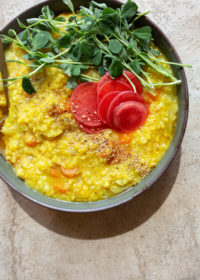Ayurveda: Rasa – The Six Tastes of Ayurveda | Astringent
This guest post from Adena Rose Ayurveda is part of a six part series on the essential tastes of Ayurveda – catch the other 5 tastes here!
This word, to me, is onomatopoetic, both in English and in Sanskrit. I’m talking about astringent today, the final of the 6 tastes in our Food as Medicine Ayurveda series. This is one of the tastes that can seem elusive, as it’s affect on the tongue is more subtle, and a majority of our foods are not dominant in this taste. Though since the rishis decided it was important enough to hold it’s own, we need to give it a proper discussion. You might be surprised how present it becomes in your life after this.
As I go deeper and deeper into my journey with Ayurveda, I am finding that the subtle is where it’s at. Subtle awareness and understanding, can yield not so subtle results. In fact, I find that so many of my clients tend to ‘forget’ they had such serious issues in the past, when I see them over time. They ‘forget’ how bad their headaches were, or how gassy and bloated they felt every afternoon…when it simply goes away with simple diet changes.
As I have discussed the other 5 tastes throughout this series here on Vidya Living, I hope the slow and steady study has brought you deeper understanding of the elements, and of the 3 doshas; Vata, Pitta and Kapha.
There are a few key important ways that Ayurveda uses food as medicine, and the tastes are one piece of the puzzle. As you have most-likely learned from reading other posts in this series, each of the 6 tastes is a way to understand how the food you’re eating can bring you closer to balance, or away from it. The taste of food is representative of the elements present within it. And the doshas, one of the ways we view our state of health in Ayurvedic medicine, are nothing but the elements as well. And of course, more of something, will give you more of it. Have a look at the handy chart below for more details:

And if you’ve yet to read my other articles, I recommend you start with something Sweet.
Astringent : Kshaya
I love how Ayurveda is so grounded. It’s principles are absolutely LANDED in nature. They are nature. The words, the terminology, is just a way to describe reality. When I found Ayurveda, I felt like I finally found a language to speak things I was already gleaning from my life experience – and I find that this is true for all of us that Fall in love with this Science.
The astringent taste is made of mostly the Air and Earth elements. The presence of the Earth element might seem counter-intuitive. The best explanation I have received, which I heard from my teacher Dr. Rosy Mann, was that when something is astringent, that sucking taste you get in your mouth is the pulling of the earth element – like the Earth feels the pull of gravity. So some describe it as more of a sensation in the mouth and on the tongue, rather than a taste itself.
The astringent taste can seem quite elusive, until you hear about the foods you’ll find it in. Astringent is not usually a dominant taste – you’re just going to find it within the flavor profile of foods. Astringency is present when a more familiar word is used – tannin. We mostly hear this in relation to tea, or wine. And yes, these two things have the astringent taste!
Along with wine, green and black tea, foods like beans, dried fruits, rye, apples, pears, pomegranate and cranberries are also astringent. Think turnip, or rutabaga, and artichoke. The peels of fruits have more astringency, as well as other foods like crackers or chip, and raw vegetables and greens, which have a general drying quality. Herbs and spices include turmeric or parsley – and many more contain this in their profiles. Also to note, as Astringent is a more elusive taste – you might come to notice that many bitter foods have astringent taste working in conjunction.
So how to use these foods for healing? Let’s go back to the elemental make-up. Air and Earth. The Earth piece being very minimal, Astringent foods are not very aggravating to Kapha, in fact, the predominance of the air element makes them more balancing for Kapha, as well as an oily Pitta situation. Their action is drying, making them mostly imbalancing for Vata dosha.
Astringent qualities are said to be cold, dry and a bit heavy. According to one of my favorite books, Eat, Taste, Heal, “Astringent taste is not as cold as Bitter taste, but has a greater cooling effect on the body than Sweet taste.” (pp. 49)
Just as when you bite into the skin of a pomegranate, say, you experience dry mouth sensation, this taste stops excess liquid flow in the body. It could stop bleeding – so say astringent herbs can be used as poultices – and water retention in the case of edema. Astringent herbs are often blood cleansers, and for example Ashoka, which is an astringent herb used often in menstrual disorders, can dry up and reduce heavy Kapha/Pitta type menstrual flows. These foods and herbs have an affinity for the water channels in the body – in a situation of excess, helping to maintain balance (like perhaps through a diuretic action) but in depletion, can be further imbalancing.
The taste reduces fat tissue, and dries up mucus membranes, so is good for use in conjunction with pungent spices and herbs in the case of obesity, or certain coughs and colds. For another example, the good ole turmeric and raw honey combo.
So this said, astringent foods and herbs are Vata-aggravating. They are cool and dry, and though considered ‘heavy’ this does not out-weigh the Vata-like qualities. This taste is too lightening, too drying for Vata or Vata imbalance, and an excess can cause cracking joints, constipation, weight loss and rigidity of the body and subtle (or not so subtle) channels.
Remember Rasa – that word meaning taste, but also vital essence, juice, and flavor and more…the medicine. Our food is not hiding it’s medicine from us, our body is built to read the signs. May this series get you started on a deeper relationship with self care and healing. The world is at your fingertips…or maybe your taste buds.
——-


 [wpmenucart]
[wpmenucart]



Great information here, but the type size is SO TINY. I bet many come and just turn away before even trying to read it, even with glasses on.
Bigger would be better. 🙂